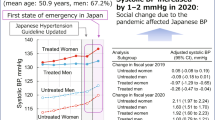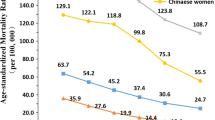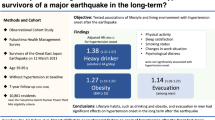Abstract
Whether tsunami survivors who suffered substantial damage experienced increases in blood pressure (BP) immediately after the disaster and in the medium to long term is unclear. We divided tsunami survivors into groups, those who relocated (substantial damage) and those who did not (little damage) and compared the BP trajectories between the groups over the first 5 years after the disaster. Of the 42,831 residents, 3914 were assessed from 2010 to 2015. Subgroup analysis was performed among the 2037 subjects with no information on antihypertensive medications between 2010 and 2015 (no antihypertensive medication group). The BP trajectories in the relocation and no relocation groups were compared using linear mixed models. The multivariate-adjusted mean systolic BP (SBP) values for all subjects significantly decreased after the disaster in both the group who relocated (2010: 130.6 mmHg, 2015: 124.8 mmHg) and the group who did not relocate (2010: 130.7 mmHg, 2015: 126.7 mmHg). The interaction between relocation and time points on SBP was significant (P = 0.017). In the no antihypertensive medication group, the SBP values in the subgroup who relocated were significantly lower in the second, third, and fifth years after the disaster than those in the subgroup who did not relocate. It was concluded that the SBP values of survivors of the tsunami caused by Great East Japan Earthquake decreased in the medium to long term after the disaster, and the group who relocated had a larger decrease in SBP than the group who did not relocate.
This is a preview of subscription content, access via your institution
Access options
Subscribe to this journal
Receive 12 print issues and online access
$259.00 per year
only $21.58 per issue
Buy this article
- Purchase on Springer Link
- Instant access to full article PDF
Prices may be subject to local taxes which are calculated during checkout


Similar content being viewed by others
References
National Police Agency. The report on Damage from the Great East Japan Earthquake. National Police Agency web site. https://www.npa.go.jp/news/other/earthquake2011/pdf/higaijokyo.pdf. Accessed 5 Jan 2020 (Japanese).
Leor J, Poole WK, Kloner RA. Sudden cardiac death triggered by an earthquake. N Engl J Med. 1996;334:413–9.
Trichopoulos D, Katsouyanni K, Zavitsanos X, Tzonou A, Dalla-Vorgia P. Psychological stress and fatal heart attack: The Athens (1981) earthquake natural experiment. Lancet. 1983;1:441–4.
Trevisan M, Celentano E, Meucci C, Farinaro E, Jossa F, Krogh V, et al. Short-term effect of natural disasters on coronary heart disease risk factors. Arteriosclerosis. 1986;6:491–4.
Ogawa K, Tsuji I, Shiono K, Hisamichi S. Increased acute myocar6dial infarction mortality following the 1995 Great Hanshin-Awaji earthquake in Japan. Int J Epidemiol. 2000;29:449–55.
Nakamura M, Tanaka F, Nakajima S, Honma M, Sakai T, Kawakami M, et al. Comparison of the incidence of acute decompensated heart failure before and after the major tsunami in northeast Japan. Am J Cardiol. 2012;110:1856–60.
Niiyama M, Tanaka F, Nakajima S, Itoh T, Matsumoto T, Kawakami M, et al. Population-based incidence of sudden cardiac and unexpected death before and after the 2011 earthquake and tsunami in Iwate, northeast Japan. J Am Heart Assoc. 2014;3:e000798. https://doi.org/10.1161/JAHA.114.000798.
Tanaka F, Makita S, Ito T, Onoda T, Sakata K, Nakamura M. Relationship between the seismic scale of the 2011 northeast Japan earthquake and the incidence of acute myocardial infarction: a population-based study. Am Heart J. 2015;169:861–9.
Kario K, Matsuo T, Kobayashi H, Yamamoto K, Shimada K. Earthquake-induced potentiation of acute risk factors in hypertensive elderly patients: possible triggering of cardiovascular events after a major earthquake. J Am Coll Cardiol. 1997;29:926–33.
Saito K, Kim JI, Maekawa K, Ikeda Y, Yokoyama M. The Great Hanshin-Awaji Earthquake aggravates blood pressure control in treated hypertensive patients. Am J Hypertens. 1997;10:217–21.
Minami J, Kawano Y, Ishimitsu T, Yoshimi H, Takishita S. Effect of the Hanshin-Awaji Earthquake on home blood pressure in patients with essential hypertension. Am J Hypertens. 1997;10:222–5.
Azuma T, Seki N, Tanabe N, Saito R, Honda A, Ogawa Y, et al. Prolonged effects of participation in disaster relief operations after the Mid-Niigata earthquake on increased cardiovascular risk among local governmental staff. J Hypertens. 2010;28:695–702.
Konno S, Hozawa A, Munakata M. Blood pressure among public employees after the Great East Japan Earthquake: the Watari Study. Am J Hypertens. 2013;26:1059–63.
Nagai M, Ohira T, Takahashi H, Nakano H, Sakai A, Hashimoto S, et al. Impact of evacuation on trends in the prevalence, treatment, and control of hypertension before and after a disaster. J Hypertens. 2018;36:924–32.
Watanabe M, Hikichi H, Fujiwara T, Honda Y, Yagi J, Homma H, et al. Disaster-related trauma and blood pressure among young children: a follow-up study after Great East Japan earthquake. Hypertension Res. 2019;42:1215–22.
Yokoyama Y, Otsuka K, Kawakami N, Kobayashi S, Ogawa A, Tanno K, et al. Mental health and related factors after the Great East Japan earthquake and tsunami. PLoS ONE. 2014;9:e102497. https://doi.org/10.1371/journal.pone.0102497.
Takahashi S, Nakamura M, Yonekura Y, Tanno K, Sakata K, Ogawa A, et al. Association between relocation and changes in cardiometabolic risk factors: a longitudinal study in tsunami survivors of the 2011 Great East Japan Earthquake. BMJ Open. 2016;6:e011291. https://doi.org/10.1136/bmjopen-2016-011291.
Kashiwagi A, Kasuga M, Araki E, Oka Y, Hanafusa T, Ito H, et al. Committee on the standardization of diabetes mellitus-related laboratory testing of Japan Diabetes Society. International clinical harmonization of glycated hemoglobin in Japan: from Japan Diabetes Society to National Glycohemoglobin Standardization Program values. J Diabet Investig. 2012;3:39–40.
Iwate Prefectural Medical Support Office. The current state of the doctor shortage. Iwate Prefectural Medical Support Office web site. http://www2.pref.iwate.jp/~hp0365/genjyo/01genjyo.html. Accessed 5 Jan 2020 (Japanese).
Iwate Prefecture Government. The critical state of the community medical. Iwate Prefecture Government web site. http://chiikiiryou-iwate.jp/genjo/index.html. Accessed 5 Jan 2020 (Japanese).
Ishikawa Y. The record of response to the Great East Japan Earthquake. Morioka: Iwate Medical Association; 2014, pp. 315–20 (Japanese).
Iwate Prefecture Government. The consultation at the medical institutions of the victims of the Great East Japan Earthquake and Tsunami. Iwate Prefecture Government web site. https://www.pref.iwate.jp/kurashikankyou/iryou/seido/kokuho/1002981.html. Accessed 5 Jan 2020 (Japanese).
Iwate Prefecture Government. The record of rebuild after the Great East Japan Earthquake and Tsunami. Iwate Prefecture Government web site. https://www.pref.iwate.jp/shinsaifukkou/fukkounougoki/joukyou/1020849.html. Accessed 5 Jan 2020 (Japanese).
Iwate Prefecture Government. Disaster area health support business management council. Iwate Prefecture Government web site. http://www.pref.iwate.jp/iryou/shinsai/kaigi/hisaichi/index.html. Accessed 13 Aug 2018 (Japanese).
Wang JG, Staessen JA, Franklin SS, Fagard R, Gueyffier F. Systolic and diastolic blood pressure lowering as determinants of cardiovascular outcome. Hypertension. 2005;45:907–13.
Miura K, Nagai M, Ohkubo T. Epidemiology of hypertension in Japan-Where are we now?. Circ J. 2013;77:2226–31.
Sega R, Cesana G, Bombelli M, Grassi G, Stella ML, Zanchetti A, et al. Seasonal variation in home and ambulatory blood pressure in the PAMELA population. J Hypertens. 1998;16:1585–92.
Woodhouse PR, Khaw KT, Plummer M. Seasonal variation of blood pressure and its relationship to ambient temperature in an elderly population. J Hypertens. 1993;11:1267–74.
Acknowledgements
This study was supported by a Grant in Aid from the Ministry of Health, Labor and Welfare, Health and Labor Sciences Research Grants, Japan (H23-Tokubetsu-Shitei-002; H24-Kenki-Shitei-001, H25-Kenki-Shitei-001(Fukkou)).
Author information
Authors and Affiliations
Corresponding author
Ethics declarations
Conflict of interest
Employment/Leadership position/Advisory role: no. Stock ownership or options: no. Patent royalties/licensing fees: no. Honoraria and fees for promotional materials: no. Research funding: no. Scholarship or donation: no. Endowed departments by commercial entities: no. Others: no.
Additional information
Publisher’s note Springer Nature remains neutral with regard to jurisdictional claims in published maps and institutional affiliations.
Rights and permissions
About this article
Cite this article
Takahashi, T., Tanaka, F., Shimoda, H. et al. Five-year blood pressure trajectories of survivors of the tsunami following the Great East Japan Earthquake in Iwate. Hypertens Res 44, 581–590 (2021). https://doi.org/10.1038/s41440-020-00607-9
Received:
Revised:
Accepted:
Published:
Issue Date:
DOI: https://doi.org/10.1038/s41440-020-00607-9
Keywords
This article is cited by
-
Seven-year incidence of new-onset hypertension by frequency of dairy intake among survivors of the Great East Japan Earthquake
Hypertension Research (2022)
-
Time course of disaster-related cardiovascular disease and blood pressure elevation
Hypertension Research (2021)



